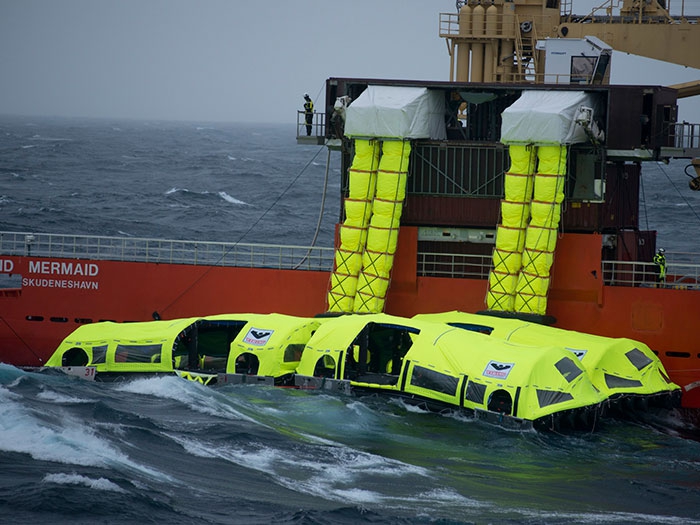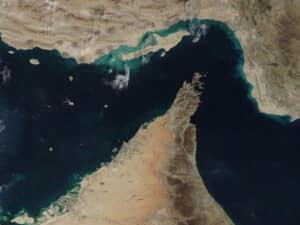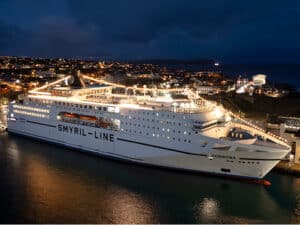
Viking’s LifeCraft solution passes demanding Heavy Weather Sea Trial
Written by Nick Blenkey
Viking LifeCraft HWST 2018
NOVEMBER 19, 2018 — Ejsberg, Denmark, headquartered Viking Life-Saving Equipment A/S reports that its innovative LifeCraft system has passed a demanding full-scale Heavy Weather Sea Trial (HWST), paving the way for cruise ship operators worldwide to benefit from all the advantages that this new hybrid solution – intended to replace lifeboats/liferafts – has to offer.
Developed and extensively tested over the past 10 years, the new evacuation system unites the advantages of modern lifeboats – such as self-propelled maneuverability – with the flexibility, comfort and smaller footprint of today’s liferafts combined with marine evacuation systems.
The solution (see video below) comprises two main elements: four inflatable VIking LifeCraft survival craft, each with a capacity of 203 persons and a fully self-contained stowage and launching appliance either placed on deck or built into the ship’s side.
 “The HWST involved launching and testing how well the LifeCraft system performs in high winds, stormy seas and extreme weather conditions,” says Niels Fraende, VP Cruise & LifeCraft. “We launched the LifeCraft with the ship heading 3 knots up against the wind, exposing the system to the full force of the fierce weather in the most critical test phase. We then demonstrated – with a simulated dead ship condition – that the fully loaded LifeCraft system provides a safe and stable means of evacuation in both the weather and lee side for several hours.
“The HWST involved launching and testing how well the LifeCraft system performs in high winds, stormy seas and extreme weather conditions,” says Niels Fraende, VP Cruise & LifeCraft. “We launched the LifeCraft with the ship heading 3 knots up against the wind, exposing the system to the full force of the fierce weather in the most critical test phase. We then demonstrated – with a simulated dead ship condition – that the fully loaded LifeCraft system provides a safe and stable means of evacuation in both the weather and lee side for several hours.
“In addition, we quickly and successfully maneuvered the LifeCraft survival crafts on both sides of the vessel to a safe distance, demonstrating their built-in flexibility to move rescue-capacity to wherever it is most needed. Simulating station-keeping while waiting for rescue, we performed a 24-hour controlled drift test in the battering seas with no damage sustained to the survival crafts.”
At the North Sea testing location between southern Norway and U.K., after being ballasted with 70 tons to simulate full capacity, the LifeCraft was subjected to wind gusts with speeds of up to 18 m/s in addition to significant wave heights of between 3.6 and 4.6 m.
The HWST consisted of multiple phases, all of which were witnessed and approved by the attending DNV GL senior surveyor acting on behalf of the Danish Maritime Authority.
Peak waves of 10 meters greatly exceeded the required 3 meters needed for the trials, with personnel from Viking and DNV GL battling sea-sickness and heaving decks to conclude the tests.
“The LifeCraft exhibited superior maneuverability, sailing away from the ship much faster than required,” says Fraende. “We achieved this with the wind at our front as well as our backs, which makes it an even more impressive feat.”
Viking says that the tests also demonstrated that the system’s flexible chute arrangement could easily cope with the ship’s list and trim, providing exceptional stability despite the highly dynamic sea state. With its four electric motors, one positioned at each corner, the fully loaded LifeCraft was swiftly maneuvered to a safe position within minutes of disengagement from its position along the ship’s side.
The trial gave crew members the opportunity to demonstrate, under extreme conditions, the capability of the chute arrangements that provide a controlled vertical passage from the embarkation point to the LifeCraft survival crafts. All landed safely at the expected evacuation speed, dry and unperturbed by the elements.
The four inflatable survival craft are powered by electric motors instead of diesel-driven units. Viking says that these not only enable excellent maneuverability for reaching a safe position or for rescuing passengers or ship’s personnel in the water, but are quieter in operation and more reliable, requiring far less maintenance. They also pose less of a fire risk and reduce evacuees’ exposure to harmful fumes. Inside, the survival craft offer triple the air space of existing lifeboat solutions and feature a novel natural ventilation system.
From a ship design perspective, the system is a significant space-saver, taking up around 25% of the necessary deck space compared to the equivalent capacity in lifeboats. This compact footprint is in itself a compelling argument for cruise ships as it frees up space for additional berths or passenger amenities. Furthermore, by enabling the positioning of evacuation capacity on both sides of a ship, the system surpasses SOLAS requirements and allows greater overall flexibility in vessel design.
With heavy weather sea trials now complete, all that remains before the system can be made available are some tests of the system’s container, along with documentation and final approval by the Danish Maritime Authority (DMA).





Leave a Reply
You must be logged in to post a comment.